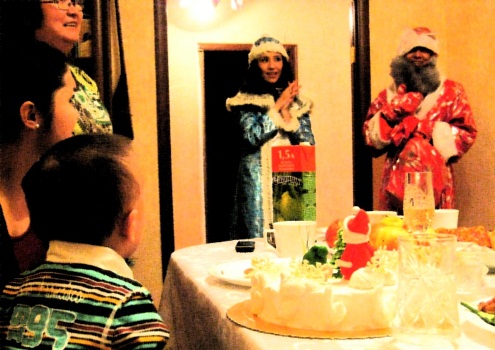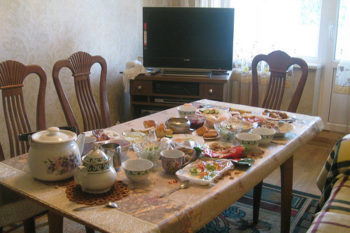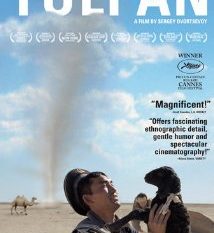It’s December 31. As I stamp my feet and shake snow off in the entrance to old Maral-apai’s flat, I’m greeted by her kelin (daughter in law) and then her husband, whose face lights up as he swings his baby grandson in the air. The guests sit and watch TV until we hear the call: “Dinner is ready!”
… and then everyone begins to put their coats on.
Yes, dinner is across town! We drive to Karima’s house, a relative who has prepared an elaborate spread, starting with New Year’s traditional olivye salad, and moving on to fish salad, raw fish slices, and caviar tarts, a burst of sticky salty orange balls in a creamy shell. There is fish soup, then baked fish sliced vertically, large bones still cross-cutting the middle.
New Year is a family holiday, and so I’m honored to be invited in as the family toasts each other, wishing happiness, health, and long life. Karima’s husband leans over and warns me, though, that there are more dinners to come. “This is why Kazakhs are “tolyk (full)” he laughs, hands shaping bulges around his stomach and hips. His wife laughs too, then smacks him on the shoulder.
But he’s correct about the feasting. We stop by a third relative’s house for tea and salads, then return to the first house. A table that was empty two hours ago is now full of salads, fresh chicken wings, and a large platter of manty dumplings filled with oil and lamb. Again the family eats, and again the grandfather closes the meal with a brief Muslim blessing, as everyone crosses their hands over their faces, “Au-meen.” This may be a Russian holiday, but it’s been comfortably adapted by Muslim families across Central Asia.
Just before midnight, Nurali’s parents disappear. The doorbell rings, and Father Christmas arrives with his snow-princess assistant. “Ho, ho, ho!” Ded Moroz cries out, and asks, “Who have we here?”

Little Nurali’s face lights up; he receives a giraffe on wound-up springs, which hops across the table and chants “again, again!” while Father Christmas gives out glasses for the grandmother, a new cell phone for the grandfather, and a compass for a younger cousin.
After Father Christmas leaves, the young parents reappaer, and ask their son, “How have you been? Did Father Christmas come?”
Nurali nods, eyes wide.
And once again everyone toasts to the New Year, as the guests begin to leave long after midnight.
~~~~
Note. Kazakhs celebrate the New Year twice: first in January with the arrival of a new calendar, and again in March with an older celebration, the arrival of spring during “Nauruz.” Since it’s January, I’ve described how one family welcomed in the new calendar year. Note also that Ded Moroz, a bringer of gifts and cheer like Santa Claus, has a Russian name that means ‘old man frost’; I’ve translated it as Father Christmas to convey a merry atmosphere to English-speaking readers!
Read more





I really loved this look into a special night, especially for the children. But, being the food-focussed person that I am, I have to ask about the seafood. Seafood and Kazakhstan? I’m not sure I would have associated those things together before reading this so I’ve really learnt something here. I’m guessing it is all fresh water fish so, is it from the Caspian, or local rivers and lakes? Also is it just for this special meal or is fish quite a usual thing in Kazakh cuisine? I shall now Google recipes like a fury.
Thanks for sharing this Celia, I really enjoyed reading aout your celebrations. Interesting that new year is such a family celebration too, whereas in England we would tend to celebrate Christmas with family but New Year with friends. Another difference that struck me was that you could drive around between houses – my friends and I tried to do that in London once, we got stuck in traffic and almost spent midnight in the car.
Marie, I’m not quite sure about the seafood, and a bit hesitant to ask. People do fish in local rivers, but I suspect most store-bought fish comes from China. In our cafeteria, we have fish probably twice a week, and you can find it in restaurants, although beef, chicken, and lamb are more typical.
And Lucy, it’s a new city and not more than a half-hour’s drive at its widest point! I find your comment interesting as well, because I’ve only had one experience with New Year’s in England (Cambridge), and it was with a friend’s family, including elderly neighbors.